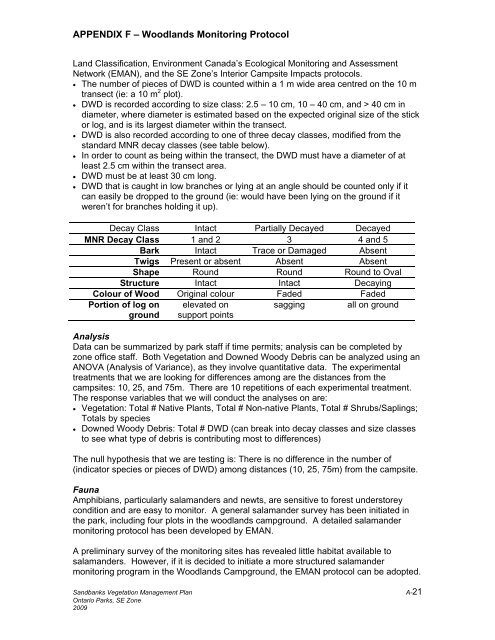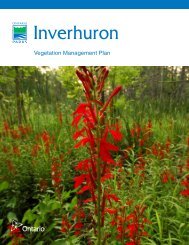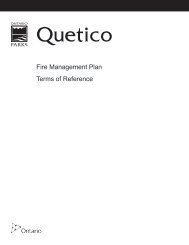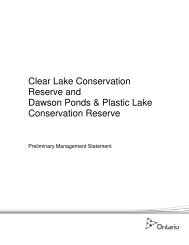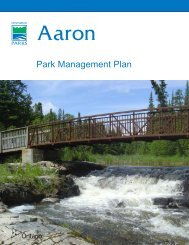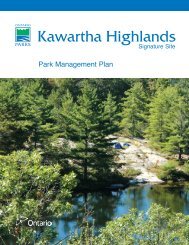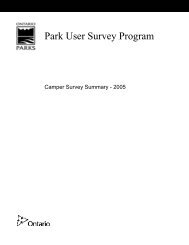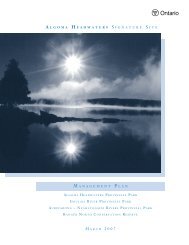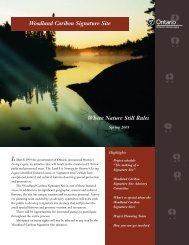Sandbanks Draft Veg Mgmt Plan - Ontario Parks
Sandbanks Draft Veg Mgmt Plan - Ontario Parks
Sandbanks Draft Veg Mgmt Plan - Ontario Parks
Create successful ePaper yourself
Turn your PDF publications into a flip-book with our unique Google optimized e-Paper software.
APPENDIX F – Woodlands Monitoring Protocol<br />
Land Classification, Environment Canada’s Ecological Monitoring and Assessment<br />
Network (EMAN), and the SE Zone’s Interior Campsite Impacts protocols.<br />
• The number of pieces of DWD is counted within a 1 m wide area centred on the 10 m<br />
transect (ie: a 10 m 2 plot).<br />
• DWD is recorded according to size class: 2.5 – 10 cm, 10 – 40 cm, and > 40 cm in<br />
diameter, where diameter is estimated based on the expected original size of the stick<br />
or log, and is its largest diameter within the transect.<br />
• DWD is also recorded according to one of three decay classes, modified from the<br />
standard MNR decay classes (see table below).<br />
• In order to count as being within the transect, the DWD must have a diameter of at<br />
least 2.5 cm within the transect area.<br />
• DWD must be at least 30 cm long.<br />
• DWD that is caught in low branches or lying at an angle should be counted only if it<br />
can easily be dropped to the ground (ie: would have been lying on the ground if it<br />
weren’t for branches holding it up).<br />
Decay Class Intact Partially Decayed Decayed<br />
MNR Decay Class 1 and 2 3 4 and 5<br />
Bark Intact Trace or Damaged Absent<br />
Twigs Present or absent Absent Absent<br />
Shape Round Round Round to Oval<br />
Structure Intact Intact Decaying<br />
Colour of Wood Original colour Faded Faded<br />
Portion of log on<br />
ground<br />
elevated on<br />
support points<br />
sagging<br />
all on ground<br />
Analysis<br />
Data can be summarized by park staff if time permits; analysis can be completed by<br />
zone office staff. Both <strong>Veg</strong>etation and Downed Woody Debris can be analyzed using an<br />
ANOVA (Analysis of Variance), as they involve quantitative data. The experimental<br />
treatments that we are looking for differences among are the distances from the<br />
campsites: 10, 25, and 75m. There are 10 repetitions of each experimental treatment.<br />
The response variables that we will conduct the analyses on are:<br />
• <strong>Veg</strong>etation: Total # Native <strong>Plan</strong>ts, Total # Non-native <strong>Plan</strong>ts, Total # Shrubs/Saplings;<br />
Totals by species<br />
• Downed Woody Debris: Total # DWD (can break into decay classes and size classes<br />
to see what type of debris is contributing most to differences)<br />
The null hypothesis that we are testing is: There is no difference in the number of<br />
(indicator species or pieces of DWD) among distances (10, 25, 75m) from the campsite.<br />
Fauna<br />
Amphibians, particularly salamanders and newts, are sensitive to forest understorey<br />
condition and are easy to monitor. A general salamander survey has been initiated in<br />
the park, including four plots in the woodlands campground. A detailed salamander<br />
monitoring protocol has been developed by EMAN.<br />
A preliminary survey of the monitoring sites has revealed little habitat available to<br />
salamanders. However, if it is decided to initiate a more structured salamander<br />
monitoring program in the Woodlands Campground, the EMAN protocol can be adopted.<br />
<strong>Sandbanks</strong> <strong>Veg</strong>etation Management <strong>Plan</strong> A-21<br />
<strong>Ontario</strong> <strong>Parks</strong>, SE Zone<br />
2009


